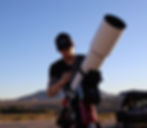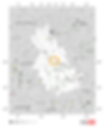LDN 1235 - The Shark Nebula - The most difficult object imaged so far
- Antoine & Dalia Grelin
- Jul 26, 2023
- 4 min read
LDN 1235, the Shark Nebula, is a dark/reflection nebula in the constellation Cepheus.
This was the most difficult deep sky object I ever had to capture since starting astrophotography, and I'll tell you all about it below!
Object Designation: LDN1235
Also known as: The Shark Nebula
Constellation: Cepheus
Object Type: Dark/reflection Nebula
Distance: 650 light-years away
Magnitude: Unknown
Discovered in: Unknown
The Shark Nebula is made up of interstellar dust, which is so thick it hides most of the light from behind it. Dark nebulae like this one are often difficult to process because they are extremely faint, and are difficult to bring out from the background medium due to how dark they are. These deep sky objects are also almost colorless, so you really cannot enhance any of the individual colors throughout the image.
I made a video about how I captured the Shark Nebula, which you can watch HERE.
The Shark Nebula Astrophotography from a Bortle 2 Sky

Knowing this was going to be a challenge, I drove 2 hours north to a Bortle 2 zone near Alamo, NV. I decided to spend an entire night there on a parking area and slept in the car while the telescope was capturing photons until sunrise.
After setting up, I immediately stumbled upon two issues:
My back-focus was off
A "rainbow-like" artifact was visible in my test shots
Because I have been using this telescope for just a couple of nights now, I have not yet been able to achieve the perfect back-focus, so the stars in the edges of the frame are elongated. This is not a problem when looking at the image from afar, but can make you puke if you decide to zoom in. With that said, please don't zoom in on the image. Thanks.
As for the rainbow artifact, I believe this is due to the fact that I am not using an IR-Cut filter. My guess is that this reflection comes from a bright star just out of the frame, I almost wanted to reframe the object hoping the reflection would go away, but did not want to take the risk as I had planned this shot for weeks. As of now I still do not know how I will attach a filter to this setup as I am using wide adapters.
Ironically, the last time I had a bright reflection was when imaging another dark nebula, the Witch Head Nebula.
The Shark Nebula - A difficult dark nebula in Cepheus
GEAR USED:
Camera: QHY600C
Telescope: Stellarvue SVX130
Mount: Paramount MyT
Guiding: ZWO ASI 290MM Mini
Accessories: Moonlite Nightcrawler focuser
Processing: Pixinsight
ACQUISITION DETAILS:
Total Exposure Time: 8 hours and 40 minutes
Exposure Time per frame: 600 seconds
Filters: N/A
Gain: 26
2023 update: I recently reprocessed the data using my current skills, and got a much better result! The shark itself looks slightly less obvious, but the overall image is more natural, and the rainbow artifact is gone!

This data was processed on PixInsight with RC-Astro plugins, and the final touches were done in Skylum Luminar Neo.
How to find the Shark Nebula

The Shark Nebula can be found in the constellation Cepheus, which is between Draco and Cassiopeia.
The Shark Nebula is not visible to the naked eye, and you won't see much through binoculars or telescopes either beside the bright stars within. It is best observed in Summer.
The Head of the Shark
The constellation Cepheus is home to a ton of space dust. The Shark Nebula is just a small part of a much larger molecular cloud full of dark interstellar gas.
If you look closely near the head of the shark, you can find two small reflection nebulae (van den Bergh (vdB) 149 and vdB 150) which are visible because they are both illuminated by the bright B8IC spectral type stars close by.
If you scroll back up to the full image and look directly to the right of the bright central star, you can spot a very far-away galaxy, designated as PGC 67671. Not much information or high resolution image can be found about this galaxy.
Single Shot & Processing of the Shark Nebula
What does a single shot of the Shark Nebula look like, and what about when 8 hours and 40 minutes of data is stacked together?
As you can see on the image on the left below, a single shot of 10 minutes on the Shark Nebula shows... almost nothing. The field looks plain dark and you would not expect it to be any large nebula in there!
When more than 8 and a half hours of those 10-minute shots are stacked though, the shark appears! The body of the animal is difficult to see, but the head is definitely popping out against the background, and so is our rainbow artifact... 😩
Processing LDN 1235 was definitely a challenge. Actually it was by far the most difficult image I ever had to process!
The Shark Nebula is surrounded by IFN, and is itself full of interstellar gas. To bring out this type of dust, experienced astrophotographers often use specific techniques on PixInsight. I myself decided to follow my usual workflow and pay extra attention to the masks used.
I did try to process the image by first removing the stars with StarNet, but in the end, I realized that this did not really help at all and decided to process everything without star removal techniques.
The screenshot below shows one of the masks used when processing the Shark Nebula. This one was done during the "ACDNR" process to remove noise.

If you'd like, you can learn how I process all our images by downloading our guide HERE. It is a full PDF "follow along" file that contains 77 pages, a full 1 hour and 45 minutes walkthrough tutorial video, our custom pre-sets for your dashboard and even raw data.
Imaging the Shark - Video
Want to come along to the Bortle 2 zone and capture the Shark Nebula with me? I made a video about the night, which you can watch below!
Final Thoughts
The Shark Nebula is definitely not a beginner target. I thought I was experienced enough to take it on but I was wrong. Well, to be honest the image did not turn out this bad but I really was expecting something much cleaner. I do intend to capture the Shark again in a year or two and will update this post with a better result, so watch out!
Have you captured the Shark Nebula? Attach your image in the comments and let us know what equipment you used!
Clear Skies,
Galactic Hunter





















